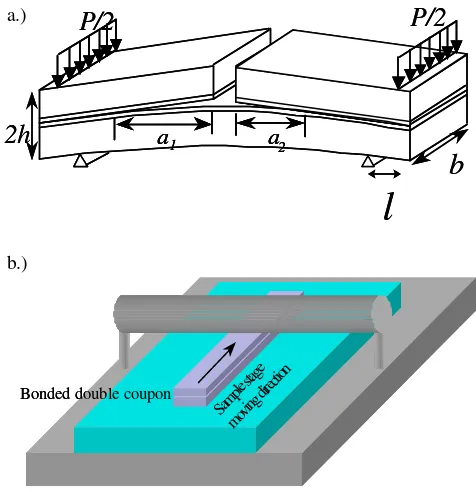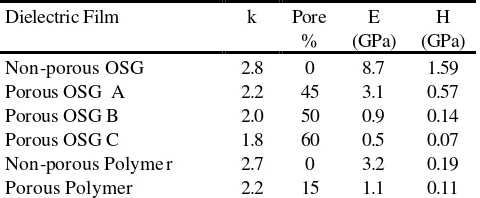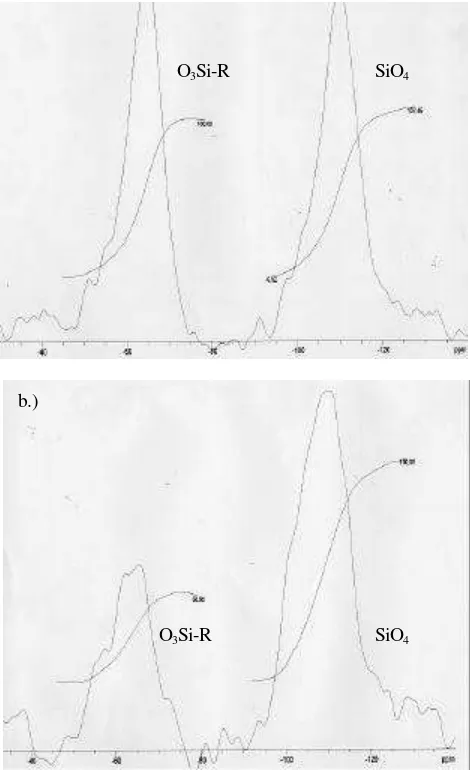Porosity Effects on Low-k Dielectric Film Strength and Interfacial Adhesion
G. Kloster, T. Scherban, G. Xu, J. Blaine, B. Sun, Y. Zhou
Abstract
The elastic modulus and hardness of low k dielectric films rapidly decrease as porosity increases. By contrast, interfacial adhesion is relatively insensitive to porosity. Adhesion energy values measured by the four-point bend method are similar for porous and non-porous films. Additionally, interfacial adhesion is much stronger for polymer films than for organosiloxane films, regardless of porosity.
E-beam treatments significantly improve the modulus and hardness of porous organosiloxane films, sacrificing only a slight increase in dielectric constant. Solid-state NMR and pore size measurements indicate that the improved mechanical properties result from a cross-linking mechanism rather than macroscopic densification. TOFSIMS results show that the increased dielectric constant results from carbon loss and an increase in silanol concentration. E-beam treatments, however, do not improve interfacial adhesion significantly.
Introduction
“Low k” dielectric films are being introduced into current interconnect technologies to meet RC delay goals and minimize cross-talk. These films generally have dielectric constants less than 3 (vs. 4 for silicon oxide) and very poor mechanical strength. The elastic modulus (E) of the low k film is typically less than 10 Gpa, compared with 72 GPa for SiO2. The poor mechanical strength of the low k dielectric films increases the risk
of thermo -mechanical failures within the Cu/low k interconnect structure, such as thin film delamination and cracking. Maintaining the mechanical integrity of the low k films with the stresses of fab processing, packaging and reliability testing has proven challenging. Next generation technologies require even lower k dielectric films (<2.5). These “ultra-low k” films may be achieved by introducing porosity. This paper will address the effects of porosity on the mechanical properties of the dielectric films. Results for two classes of materials will be presented, organosiloxane-based films
(deposited either through CVD or spin-on methods) and polymer films. Methods to enhance the mechanical strength of porous siloxane films will be discussed.
Experimental
Elastic modulus and hardness were measured on 1-2 micrometer films using the technique of nanoindentation. A MTS Nano XP nanoindenter with a Berkovich diamond tip was used to carry out the measurements. Each sample was analyzed using fifteen indents. Samples were loaded in continuous stiffness mode. The modulus was calculated using a shallow contact depth range of <150 nm to avoid substrate interaction effects, which can be pronounced for very low k films.
Interfacial adhesion was measured using the technique of four-point bending [1]. Samples consisting of multi-layer blanket thin film stacks deposited on silicon substrates were cleaved from the wafer and bonded face-to-face to a silicon backing such that the thin film stack is sandwiched in the center of the sample beam, as illustrated in Figure 1a. To obtain a uniform bonding layer, the sample was processed in a bonding tool, shown in figure 1b. Interfacial adhesion energies (Gc) were obtained from the load vs.
displacement output according to the equation
(
)
Figure 1. a.) 4-point bend configuration, b.) bonding tool used to prepare four-point bend samples
a.)
in which E and ν are the elastic modulus and Poisson's ratio of the Si substrate, respectively, and P is the applied load.
Dielectric constant measurements were made using the mercury probe method. Values at 0.1 MHz were obtained, and confirmed in some cases using metal-insulator-silicon (MIS) structures. Porosity values were approximated using the Debye equation and have been verified by ellipsometric porosimetry for most materials. Pore sizes were measured by positronium annihilation lifetime spectroscopy (PALS) and ellipsometric porosimetry.
Effect of Porosity on Modulus, Hardness and Adhesion
The effect of porosity on the elastic modulus and hardness of organosiloxane and polymer films is shown in Table 1. As porosity increases, k decreases and the elastic modulus and hardness drop. The elastic modulus and hardness are 2-3x lower for OSG films with 45% porosity than for OSG films that are non-porous. Further, the modulus and hardness drop over an order of magnitude relative to the non-porous film when the porosity of the OSG film is increased to 60%. For the polymer film, the introduction of 15% porosity reduces the elastic modulus by 3x and the hardness by less than 2x. It is interesting to note that at similar k values the non-porous OSG film has over 2x the elastic modulus and over 7x the hardness of the non-porous polymer film. The very low hardness of these polymer films presents an increased risk of thermo -mechanical failure of interconnect structures by shearing mechanisms, particularly in low metal density areas such as via structures.
The effect of porosity on interfacial adhesion is shown in Table 2. A thin film stack consisting of etchstop/ILD/Si was used to measure adhesion of the etchstop film to the ILD film. A stack consisting of electroplated copper/ copper seed/ barrier metal/ ILD/ Si was used to measure adhesion of the barrier film to the ILD film. It has been shown previously that a Gc value of > 5 J/m
2
is required for the film stack to survive chemical mechanical polishing with no thin film delamination [2]. The data in Table 2 indicate that interfacial adhesion is relatively insensitive to the introduction of porosity. Porous and non-porous organosiloxane materials show similar adhesion values regardless of porosity. Additionally, porous and non-porous polymers show equivalent adhesion. It has been previously shown that surface treatments, such as plasma and sputtering treatments, have a pronounced effect on interfacial adhesion [2]. Adhesion is much better for the polymer films than for the OSG films.
Table 1. Effect of Porosity on Modulus and Hardness Dielectric Film k Pore
Table 2. Effect of Porosity on Interfacial Adhesion Dielectric Film Capping
Non-por. Polymer TaN 2.7 0 >20 Porous Polymer TaN 2.2 15 >20 TiNSi barrier is CVD; TaN barrier is PVD.
E-beam Treatments
Methods to enhance the mechanical strength of ultra -low k films were investigated to counter the large decrease in mechanical strength observed when porosity is introduced. E-beam treatments significantly improve the modulus and hardness of porous organosiloxane films, sacrificing only a slight increase of the dielectric constant (Table 3). Comparison of the solid-state 29Si NMR spectra for organosiloxane films with and without e-beam treatment reveals that the ratio of fully cross-linked to partially cross-linked Si atoms increases in the film after e-beam exposure (Figure 2). However, the materials do not appear to undergo macroscopic densification since the pore size and measured porosity remains unchanged after e-beam exposure.
The dielectric constant increases by approximately 10% after e-beam exposure. TOFSIMS depth profiling indicates that carbon is uniformly depleted by about 50% throughout
Table 3. Effect of E-beam on Organosiloxanes Treatment k E
(GPa) H (GPa)
Gc
(J/m2) No E-beam 1.8 0.5 0.1 3.7 ± 0.1 Low Dose 2.0 2.4 0.3 4.1 ± 0.2 High Dose 2.2 3.7 0.4 3.6 ± 0.6 Gc is for adhesion to an etch-stop layer
the film. The carbon depletion, however, does not fully account for the increase in k. TOFSIMS also indicates that the silanol content in the film doubles upon e-beam exposure The increased silanol concentration probably accounts for much of the increase in the dielectric constant.
It is well known that materials with polar surfaces tend to show stronger adhesion energies. The increased silanol concentration in e-beam treated organosiloxanes, therefore, might be expected to improve interfacial adhesion. However, the data in Table 3 show that e-beam treatments have little effect on the adhesion over a range of e-beam doses. The silanol groups may not be concentrated enough near the surface to affect interfacial adhesion.
Ultra low k materials currently in development are generally fabricated by introducing porosity into films of low dielectric constant, such as organosiloxanes or organic polymers. Porosity severely degrades the mechanical strength of the dielectric materials, as measured by the elastic modulus and hardness. By contrast, porosity has little effect on the interfacial adhesion energies. Four-point bend measurements produce similar adhesion energies for porous and non-porous films. Additionally, the trend that organic polymers generally have higher adhesion energies than organosiloxanes is true for both porous and non-porous materials. It has been previously shown that surface treatments, such as plasma and sputtering treatments, strongly modulate interfacial adhesion [2].
E-beam treatments improve the mechanical strength of porous organosiloxane films by inducing microscopic cross-linking. The small increase in dielectric constant that accompanies e-beam treatment appears to arise from a combination of carbon depletion and an increase in silanol concentration. The increase in silanol moieties from the e-beam treatments, however, does not affect interfacial adhesion values.
References
[1] Q. Ma, " A Four-Point Bending Technique for Studying Subcritical Crack Growth in Thin Films and at Interfaces," J. Materials Research, 12, 840-845, 1997.
[2] T. Scherban, B. Sun, J. Blaine, C. Block, B. Jin, E. Andideh, “Interfacial Adhesion of Cupper-Low k Interconnects”, in 2001 IEEE International Interconnect Technology Conference Proceedings, pp 257-259
O3Si-R SiO4
O3Si-R SiO4
b.)



